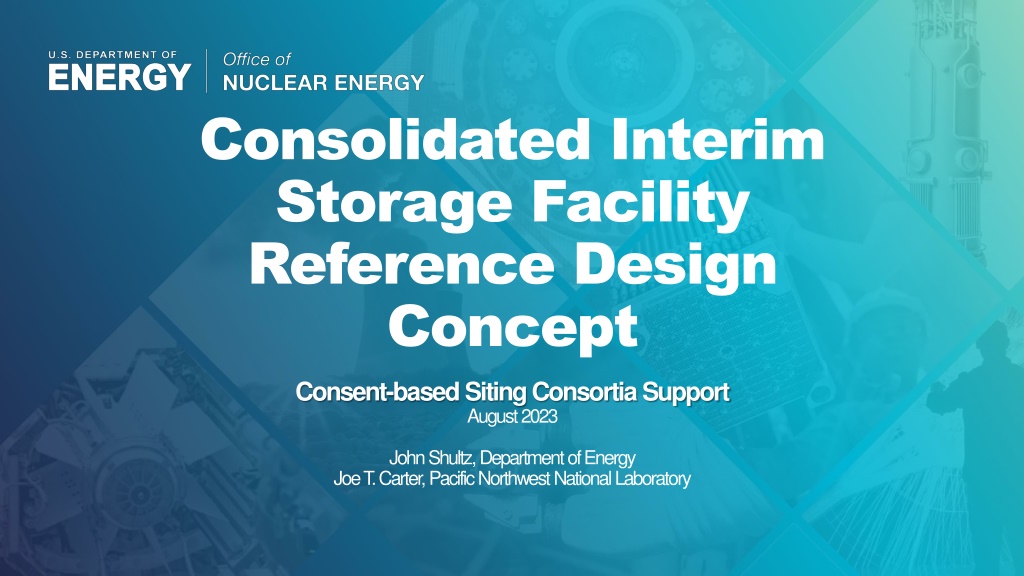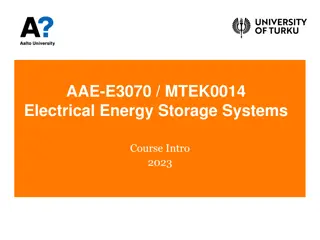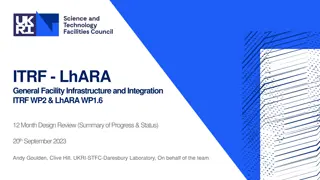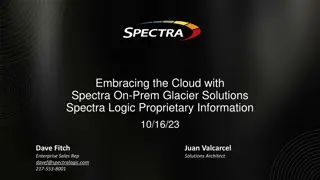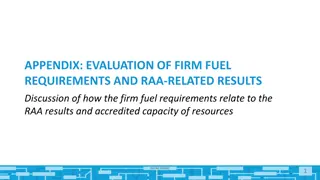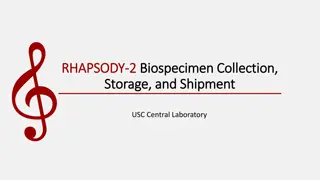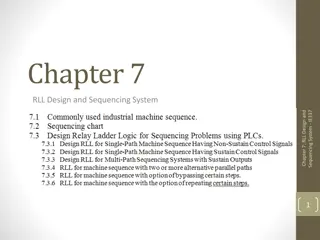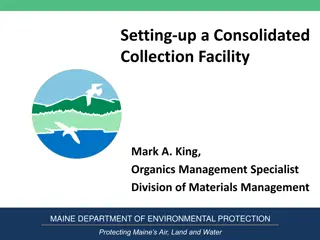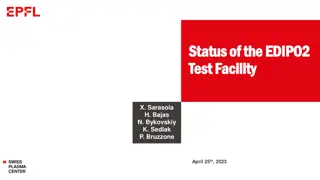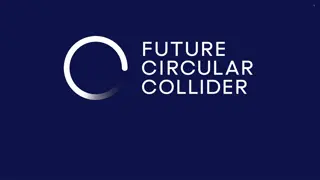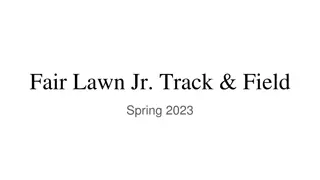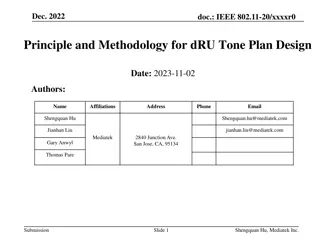Temporary Storage Facility Design Concept Overview
Technical presentation on the design concept of a Consolidated Interim Storage Facility for spent nuclear fuel and high-level radioactive waste. The concept includes a reference design, independent cost estimates, and site plan details for potential host communities. The design features cask-on-a-pad storage configurations, simplified licensing strategies, and adherence to vendor market share. The presentation emphasizes community discussions, economic impacts, and government cost estimates.
Download Presentation
Please find below an Image/Link to download the presentation.
The content on the website is provided AS IS for your information and personal use only. It may not be sold, licensed, or shared on other websites without obtaining consent from the author. Download presentation by click this link. If you encounter any issues during the download, it is possible that the publisher has removed the file from their server.
Presentation Transcript
Consolidated Interim Storage Facility Reference Design Concept Consent-based Siting Consortia Support August 2023 John Shultz, Department of Energy Joe T. Carter, Pacific Northwest National Laboratory
Disclaimer This is a technical presentation that does not take into account contractual limitations or obligations under the Standard Contract for Disposal of Spent Nuclear Fuel and/or High-Level Radioactive Waste (Standard Contract) (10 CFR Part 961). To the extent discussions or recommendations in this presentation conflict with the provisions of the Standard Contract, the Standard Contract governs the obligations of the parties, and this presentation in no manner supersedes, overrides, or amends the Standard Contract. This presentation reflects technical work which could support future decision-making by the U.S. Department of Energy (DOE or Department). No inferences should be drawn from this presentation regarding future actions by DOE, which are limited both by the terms of the Standard Contract and Congressional appropriations for the Department to fulfill its obligations under the Nuclear Waste Policy Act including licensing and construction of a spent nuclear fuel repository.
Consolidated Interim Storage Facility (CISF) Reference Design Concept - Purpose Why? Provides a Starting Point for Host Community Discussions o How Big? o What Does it look like? o Basis for Economic Impact, jobs, taxes, etc. Provides an Independent Government Cost Estimate o For Project Management o For Potential Host Communities Information Based on DOE Contractor Studies Task Order 11- Areva, Energy Solutions, Chicago Bridge and Iron (now APTIM) Task Order 16 CB&I (now APTIM) Topical Safety Analysis Report and Generic Design Report APTIM/Holtec/Longnecker Augmented by National Laboratory Studies
Reference Concept Overview Reference Concept Utilizes Cask on a Pad Like for Like Horizontal Canister Configuration Stays Horizontal Vertical Canister Configuration Stays Vertical New Storage Cask Purchased Not Reused Vendor Market Share is Maintained Licensing Strategy is Simplified Incorporation by Reference of Storage Systems (not transfer casks or other handling equipment) Canister Handling, No Spent Nuclear Fuel (SNF) assembly level handling. Potential Host may have other Preferences
Reference Concept Reference Concept Site Plan Site Plan CISF site owner controlled area (OCA) 5.5 sq-miles (3,540 acres) 4,800+ feet stand-off distance from edge of storage pad edge to OCA operations area (OA) 1.9 sq-miles (1,210 acres) fence boundary and perimeter road includes administration and maintenance structures, Storage Cask Fabrication Facility, and OA railyard protected area (PA) includes security and inspection structures, Cask Handling and Transfer Facility, dry storage pad, and PA railyard
Owner Controlled Area at Completion 70,000 MTU Horizontal Storage (black), Vertical Storage (red) OCA Signage Second Cask Handling Bld Operations Area Fence Transport Cask Maintenance Packaging/ Treatment Bld Cask Handling Bld PA Fence
Basis for Reference Concept SNF Canisters in their NRC certified transport casks on either Fortis or Atlas railcars. 17 Rail Casks Heavy Haul Truck Receipt is considered Truck casks are not anticipated but can be received
Cask Handling Building Plan View Two Operating Lines Dual railcars unloading North and South Two 230 ton cranes, common rails Two Shielded Carts, Common Cart Rails 1500 MT single shift 5 days/week operations Add Shifts to Increase Capacity Cells Provide Shielding and Natural Hazard Protection Building Seismic, Natural Hazard Qualified
Vertical Cask Handling Concept Security Inspections upon Entry into the Protected Area Receipt Inspection Activities Conducted upon Cask Handling Building Entry Canister Pressure Boundary Integrity Check Transportation Cask is up righted and moved to cell Lid Bolts Removed Lid Removed Remotely Canister is lifted into Shielded Transfer Cart Cart is Moved above the Storage Cask Canister Lowered Lid secured to Storage Cask Cask Transferred to Storage Pad SHIELDED TRANSFER CART DRY STORAGE CANISTER VERTICALTRANSPORTATION CASK UNLOADING CELL VERTICALSTORAGE CASK LOADING CELL VERTICAL STORAGE CASK TRANSPORTATION CASK
Horizontal Cask Transfer Railcar unloaded in Cask Handling Building Cask placed on Horizontal Transporter Transferred to Storage Pad Canister Transferred to the Horizontal Storage Module
Dry Storage Pad Pads built to withstand natural hazards and seismic events Vertical Casks and Horizontal Storage Modules provide substantial penetration resistance as defined by 10CFR 73.51(d)(1) In high seismic areas, restraints may be added to prevent sliding and tipping
Storage Configuration for 70,000 Metric Tons Uranium Storage and Reactor Decommissioning Greater-than-Class C (GTCC) Waste Vertical Cask Pad 70,000 MTU Storage Pad covers 125 acres HSM Pad SNF Storage GTCC Waste Storage Total Quantity of Canisters 250 3,580 Total Dry Storage System Quantity of Storage Arrays 5 72 Storage Arrays 1 Storage Arrays 1 Canisters 2 Casks/Canisters Bare Fuel Vertical Canister Horizontal Canister Total 250 3,400 5 68 0 0 4 180 2,200 44 45 1 2,245 45 5,850 117 225 5 6,075 122
Inspection and Remediation Facility Concept NOT required for Initial Operations CISF will have 6,000 to 12,000 DPC in storage under aging management plans Continued in-situ canister inspections not practical IRF provides capabilities to receive a cask from storage, remove a DPC from its cask, reorient the DPC, transfer the DPC into a shielded structure, remotely inspect the DPC through Nondestructive Examination (NDE) methods, remotely repair, if necessary, and perform overpacking operations, if necessary. DPC Inspection Cradle Modular End Effectors Handling Cask and Horizontal Transporter Placeholder Remote Equipment
Packaging Facility Concept NOT Required for Initial Operations Potentially Required for: Packaging current Dual Purpose Canisters (DPC) that do not meet disposal facility acceptance criteria Treating the existing DPC so they become disposal facility acceptable Receipt of Bare Fuel Assemblies that Must immediately packaged for storage/disposal Other storage scenarios e.g. re-packaging as described in the Nuclear Regulatory Commission (NRC) Continued Storage EIS Facility Description Receipt of SNF DPC or Cask transferred to the shielded facility DPC or Cask Opened Assemblies transferred to a new canister New canister closed SNF transferred to storage
Packaging Facility- Plan Reorientation (Hot) Cell Accessed from Both Sides Fuel Handling Gallery Connects Cells Capacity Defined by Number of cell, size of the Loaded Canister Weather cover not shown
Cost Estimates Cost Estimate Only for Initial Deployment 3 Storage Pads (2 vertical, 1 Horizonal orientation), build as you go approach Cask Handling and Transfer Building Equipment Balance of Plant Support Facilities Assumptions Government Owned Contractor Operated Model DOE Order 413.3 Cost Allowance for a 20 mile rail spur to service the site TSAR, Generic Design Report Cost Estimate, FY2017 Basis
Total Estimated Cost (TEC)* *Cost estimates reflect 2017 data and would need to be adjusted based on site-specific design and passage of time.
Total Project Costs (TPC)* *Cost estimates reflect 2017 data and would need to be adjusted based on site-specific design and passage of time.
Staffing ~190 Full Time Employees 1500 MT/yr receipt rate Higher for 2 additional Cask Handling Facility Crews
Capitalized Operating Expense Annual Pad Storage
Thank You Questions
